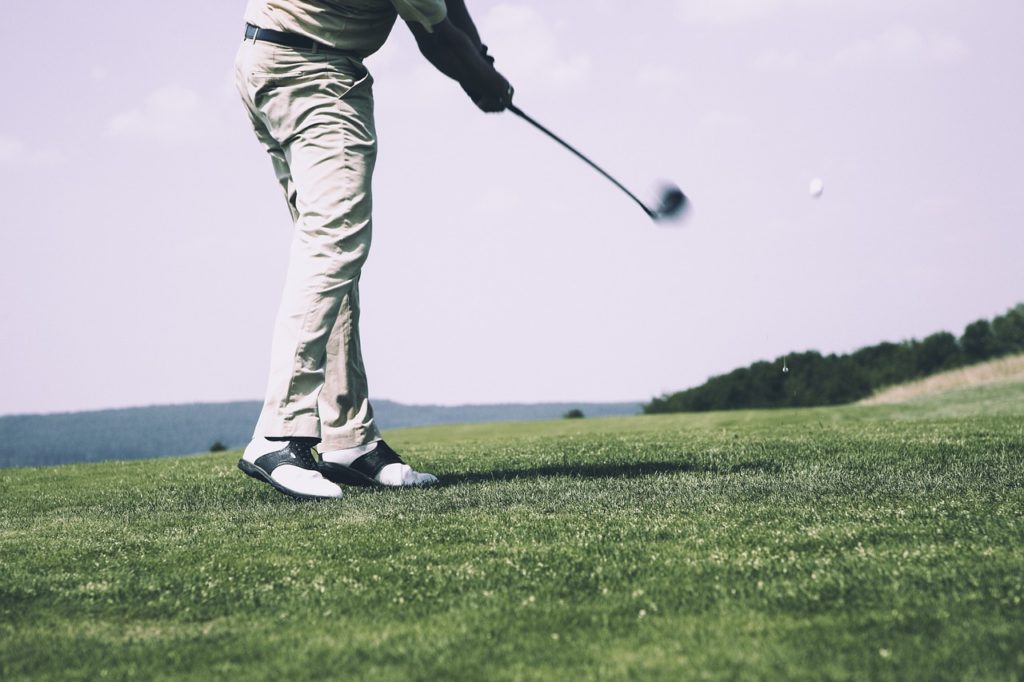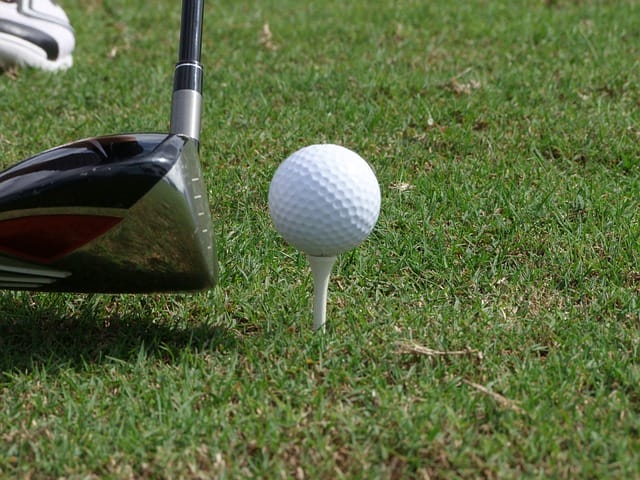If golf were just one swing, the game would be considerably easier. However, as any great player will tell you, there is quite a bit more to the game than just the one swing. The driver swing vs. iron swing is a very popular question for amateur players. How much difference is there? Will you ever be able to learn both the iron swing and the driver swing?
Sometimes this is made out to be a bit more complicated than it is. In our comprehensive guide, we will show you everything you need to know about both the driver swing and the iron swing so that you can make progress in your game.
Driver Swing

The driver swing is used from the tee box to get the hole off to a great start. A golf driver swing is also very similar to a fairway wood swing, so most of this information will transfer into the fairway woods as well.
There are four basic areas of the driver swing that we will look at, including the setup and stance, swing plane, impact position, and follow-through.
Setup and Stance
Your setup with the driver will be the widest out of any of the golf shots in your bag. The driver is the longest club in the bag and requires golfers to have a very stable base to be able to maintain an athletic position.
The golf ball will be positioned towards the lead foot; for right-handed golfers, this is the left foot. The ball is slightly inside the left heel, with the driver feeling noticeable forward in your stance.
Golfers should feel as though they are standing a bit more upright, allowing for the widest arc and longest path for the driver. If you get the setup and the stance right, the rest of the swing will become a bit easier.
Swing Plane

The swing plane for a driver needs to be more shallow than it is for an iron swing. This has to do with the length of the golf club and the angles necessary for proper impact.
Golfers that have a more upright swing path will struggle with the ability to get the proper ball flight on their drivers. An upright golf swing typically leads to a drive that slices. Please take a look at the angle of the club at set up with a driver and at set up with an iron; it is easy to see why the plane is naturally more shallow.
Impact
The impact position with a driver is unique. Players will hit the ball on the upswing. As golfers move through impact, the driver will hit the ball as it goes up instead of going down, as you will see with the irons.
Impact in this position allows for slightly higher ball flight and a much longer drive. The driver is one of the lowest lofted clubs in the bag, and you cannot hit this club on your downswing, or it will not get the ball flight that you need.
Follow Through
The follow through of the driver swing is very important. Golfers must continue rotating towards the target and finish with the club high and above their left shoulder. The follow through should be well balanced and complete to hit long and straight drives.
Iron Swing

Now that you have the basics of the driver swing, it’s time to look at the iron swing and the impact that this can have on your game. The first thing to notice here is that the iron is much shorter than the driver. Having a shorter club in your hand will impact quite a bit and make the differences between these clubs more noticeable.
Setup and Stance
The iron setup should allow a golfer’s feet to be about shoulder width apart. This distance between the feet encourages players to be able to have an efficient and quick turn and increase the overall speed in their golf swings.
For most irons in the bag, the golf ball should be located in the center of the stance. As you move towards the longer irons, the ball may move up a bit, but never as far up as we see something like the driver.
Swing Plane
The swing plane for the iron swing is a bit more upright than it is for the driver swing. A more upright swing plane with the iron will encourage golfers to hit down and through their shots with a tremendous amount of force and spin.
If you don’t get your iron swing upright enough, you will have a hard time with taking a divot and getting the proper ball flight. Golfers that try and use more of a driver swing with the iron in their hand will lose the ball flight that they need as well.
Impact
The impact is the position we are in when we hit the ball. With the iron swing, you will hit the ball on the downswing, which encourages the high ball flight and the spin that you need to hit those high flying shots.
If the impact is happening on the downswing, the ball also becomes easier to control and to stop. In order for impact to occur on the downswing, golfers need to be good at transferring their weight and directing the club down and into the ground.
Follow Through
Just like the driver swing, the follow through in the iron swing is equally as important. Golfers must work to get their weight transferred forward to the left side and get the club up high when they finish.
The follow-through is essential as it helps promote more acceleration through the impact position and better distances for your iron shots. The follow-through should be balanced and leave golfers looking directly at their target.
Should Your Driver and Iron Swing Be The Same?

The iron swing and driver swing are not the same. If you try and swing the same way with your driver and your iron, one of the two shots will suffer.
Essentially a driver swing is too shallow to help an iron shot get up in the air. In addition, the driver is hit on the upswing, encouraging a higher ball flight with a lower lofted club.
The iron swing is too upright for golfers that are trying to swing with a driver. In fact, as a golf professional, one of the major issues I was faced with was golfers that had a swing that was too upright to hit a driver.
These players would end up slicing almost all of their driver shots, and it became challenging for them to get away from this process. It doesn’t matter what brand or style of golf club you are playing, there is a clear difference between a driver swing and an iron swing, and it needs to be played like that.
The only good news here is that the basic fundamentals of these swings can be simplified to work for both. The adjustments you must make between the two swings can be minor if you have great fundamentals.
The Differences Between the Driver Swing and Iron Swing
There are two main differences between the iron swing and the driver swing. These differences are the swing speed and the impact position. The reason these two differences come up is because of the length and style of each of these golf clubs.
Speed
The speed of a golf driver is considerably higher than the speed of an iron swing. The driver is intended to go very far, and therefore golfers will swing at it with more speed and effort.
In addition, the golf driver is made more lightweight so that it can be swung on a wider arc with considerably more speed. Although golfers will still want to be able to control their drivers, control is not the biggest concern.
Control with the irons is the concern, and this is why you will notice that the speed associated with the iron swing is a bit more controlled. In addition, irons are heavier, and this will impact what you can do with them as well.
Impact Position
The impact position is where you will make contact with the ball. For the driver swing, this is going to be on the upswing. After your swing hits the very bottom of its arc and as it moves towards the follow through, you will hit the impact zone with the driver.
With the golf iron, the impact position happens sooner at the bottom of the swing arc. This encourages golfers to take a divot and increase the overall launch that they get with their golf clubs.
Overall the impact position is critical to note because it can make or break your success in your golf game.
Similarities Between Iron vs. Driver Swing
The golf iron swing and driver swing have plenty of similarities between them. Golfers should not be nervous or overwhelmed about trying to learn both of these swings. As long as you can make some basic adjustments to your setup, stance, and swing plane, you can easily switch between the driver and the iron golf swing.
Balance and Control
Every golf swing you take should have a good amount of balance and control. Anytime that you feel your tempo is so off that it throws you out of balance, you need to back things up a bit and figure out what the issue is.
If you happen to get an extra 2mph of swing speed, but you are struggling to stay on your feet when you finish, it is not at all worth it.
Follow Through Position
Even though you will be holding different clubs in your hand, when you get to the full and complete follow through with a golf iron or driver, you will be facing your target with your hands held high.
At this point, all of your weight will have been transferred to your left side. This weight transfer helps improve the overall power and consistency of your golf swing.
If you do drills to work on your follow through, it will help with the results you see with both your driver and your irons.
Head Control
Golfers need to keep their head controlled in their swing. There should be very little horizontal movement of your head during the swing. In addition, there should be very little vertical movement.
For many years golfers were taking their heads off the ball to try and create more power and distance. Today we have learned that a more compact golf swing with the head staying mostly over the ball is considerably more effective.
Learning these basic things and how they will impact your golf swing can help you play better iron shots and better drives. Most of the issues that golfers have in their swing have to do with trying to create too much power when it is not really necessary.
Tips to Improve Your Golf

Golfers are always looking for that one tip to help improve their game. There are a few key things you should know about the driver vs. iron swing, but first, it’s essential to manage and control the tips that you allow to sneak into your head.
Most golfers have way too many swing thoughts. These thoughts can sometimes get in the way of you normally thinking and swinging more naturally. Try to keep your swing thoughts down to just one or two things.
Let these things test in your head for several rounds before you start changing them up. Golfers need to be smart about tips if they want to see the benefit they can provide.
- Take videos of your driver swing and iron swing so you can compare them, this can be a simple cell phone video, but it will clarify all of the differences we have described.
- When practicing on a driving range, try to hit one iron shot, a driver, a wedge, another iron, etc. Don’t stand on the range and hit 14 golf shots with the same club. Chances are you will get very good at that club, but you won’t have the ability to switch back and forth between your clubs.
- Work on your athletic ability and mental mindset just as much as you work on the positioning of your golf swing. The brain is a very powerful tool, and if you can train it right, your golf swing will benefit from it. In addition, when you are in good physical shape, it is much easier to make changes in your swing and see quick results.
Conclusion
We hope that you can now see the driver swing vs. iron swing and all that goes into this. The overall process of learning a driver swing as opposed to learning an iron swing is quite simple. Players need to focus on the differences in the setup as well as the impact position. Take a look at your golf clubs and notice the differences between the iron and the driver. These differences will hopefully help you see why the swings need to be slightly different to get the proper results.

